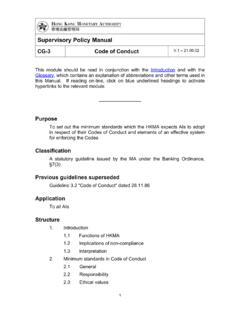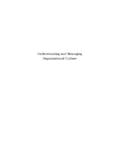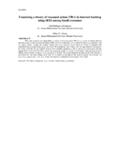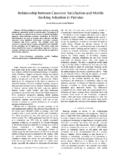Transcription of The Organisational Structure of Banking Supervision
1 FSI Occasional PapersNo. 1 November 2000-10-25 The Organisational Structureof Banking SupervisionbyProf. GoodhartFinancial Stability InstituteBank for International SettlementsBasel, SwitzerlandCharles Goodhart, CBE, FBAis the Norman Sosnow Profes-sor of Banking and Finance at the London School of Economics(LSE). Before joining the LSE in 1985, he worked at the Bank of England for seventeen years as a monetary adviser, becominga Chief Adviser in 1980. In 1997 he was appointed one of the outside independent members of the Bank of England s newMonetary Policy Committee until May 2000. Earlier he hadtaught at Cambridge and LSE.
2 Besides numerous articles, he haswritten a couple of books on monetary history, and a graduatemonetary textbook,Money, Information and Uncertainty(2ndEd. 1989); and has published two collections of papers on monetary policy,Monetary Theory and Practice(1984) and The Central Bank and The Financial System (1995); and an institutional study of The Evolution of Central Banks,revisedand republished (MIT Press) in Organisational Structure of Banking SupervisionForewordvAbstractviiI. Introduction1II. Arguments for Separation8 III. Arguments for Unification24IV. Are the Issues the Same in Emerging Countries?
3 34V. Conclusions43 Bibliography45vForewordIt gives me great pleasure to present this first in a series of occasional papers published by the Financial Stability purpose of these papers is to create awareness of, and pro-vide information on, topics of interest to financial this first paper the Financial Stability Institute requestedProfessor Charles Goodhart (London School of Economics) towrite about Banking Supervision and its relationship to , it has been considered ideal to place Banking Supervision under the umbrella of central banks because thisfunction is key to the conduct of monetary policy and financialstability , many countries around the world have been movingbanking Supervision outside their central banks.
4 What are theadvantages and disadvantages of this policy decision? ProfessorCharles Goodhart addresses this question. Furthermore, an im-portant contribution of his work is to focus this issue from the point of view of emerging-market present this work with the hope that it will provide policymakers with key factors they should take into consideration inthe design of the most appropriate Structure of their G. HeimannChairmanFinancial Stability InstituteNovember 2000viiThe Organisational Structureof Banking Supervisionby Prof. Goodhart1 Financial Markets GroupLondon School of EconomicsAbstractIn this paper I try to address the question of whether, and why, itmatters whether Banking Supervision is undertaken in-house inthe Central Bank or in a separate specialised supervisory institu-tion.
5 After all, the Banking supervisors and those in the CentralBank concerned with systemic stability must continue to workclosely together wherever the supervisors are physically there has been some recent trend towards hivingoff Banking Supervision to a separate agency, as with the Finan-cial Services Authority (FSA) in the UK. The main drivingforces behind this tendency are the changing, more blurred, Structure of the financial system, and continuing concerns withconflicts of interest. As the dividing lines between differingkinds of financial institutions become increasingly fuzzy ( banks), continuing Banking Supervision by the CentralBank threatens both inefficient overlap between supervisorybodies and a potential creep of Central Bank safety net, andother, responsibilities into ever-widening areas.
6 With the accom-panying trend towards Central Bank operational independencein monetary policy, continued Central Bank supervisory 1My thanks are due to P. Armendariz, C. Briault, G. Caprio, T. Dubouchet, P. Jackson,G. Kaufman, R. de Krivoy, D. Llewellyn, G. Schinasi, D. Schoenmaker, M. Taylor,P. Tucker, D. Walker, W. White, and participants at a BIS seminar for helpful for all views and remaining errors remains with enhances concerns about potential conflicts of interest,and raises issues about the limits of delegated powers to a non-elected the other hand, separation of Supervision from the CentralBank raises questions whether systemic stability might ethos, culture and concerns of the separate supervisory bodymight come to focus more on conduct of business and customer protection issues.
7 Potentially systemic financial crises wouldhave to be handled by a committee, not by a unified CentralBank. How much, if at all, would the collection, transmissionand interpretation of information relevant to a Central Bank sconcerns, both on monetary and systemic stability policy issues,be lost as a consequence of separation?These are, mostly, qualitative issues, and more developed countries, with differing historical, legal and institutional backgrounds, will, and have, come to differing conclusions. But in less developed countries, more weight needs to be placed on ensuring the quality of the supervisory staff, theirprofessional skills, independence from external pressures, andadequate funding.
8 These latter considerations tell strongly towards retaining Banking Supervision under the wing of the Central Bank in emerging IntroductionIn 1997 the newly elected Labour Government in the UnitedKingdom transferred responsibility for the prudential supervi-sion of commercial banks from the Bank of England to a newlyestablished body, the Financial Services Authority (FSA). TheFSA was to take on responsibility for, and combine, both theprudential and the conduct of business Supervision for virtuallyall financial institutions (banks of all kinds, finance houses,mutual savings institutions, insurance companies, etc.)
9 , and financial markets. So, during the course of 1998 most of thebanking supervisors who had been working together in a desig-nated section of the Bank moved together, en bloc, to the newheadquarters of the FSA at Canary Wharf, a few miles same people continued to do the same job. What then had changed?2 Moreover, the commercial confidentiality of their work had meant that their offices in the Bank had previ-ously been sealed off internally from the rest of the Bank (Chinese Walls!). Given the increasing ease of long-distancecommunication (by e-mail as well as telephone and fax), wouldchannels of information really be that much changed by thephysical move?
10 2 The FSA would, I believe, argue that what has changed is that it can take advantage of the efficiency benefits of a unified supervisor, to be discussed in Section (II)(a) below,by putting greater emphasis on the integrated Supervision of financial groups, and, moregenerally, put the regulation of banks on a basis that is more closely correlated with theregulation of other parts of the financial services industry (see A New Regulator for theNew Millennium , FSA (2000)).2 One possible answer could be that both the physical location and the Organisational Structure of the financial Supervision ofbanks are, indeed, a second-order problem.














